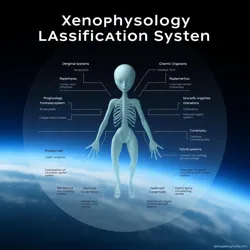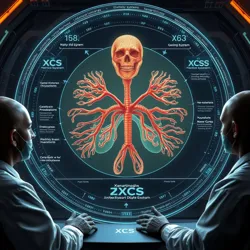Xenophysiology Classification System
The Xenophysiology Classification System (XCS) is a comprehensive taxonomic framework developed in 2187 for categorizing and comparing alien biological systems. Originally proposed by the Interstellar Biological Standards Committee, the system has become the primary method for organizing xenobiological research across known space.
 A standardized XCS diagram showing the primary classification branches for metabolic systems across different atmospheric types
A standardized XCS diagram showing the primary classification branches for metabolic systems across different atmospheric typesCore Classification Categories
The XCS divides all known alien physiologies into five primary domains:
-
Bioelectric Systems - Organisms that utilize electrical impulses for primary life functions
-
Chemical Processors - Life forms based on conventional molecular metabolism
-
Radiotrophs - Entities that harvest energy directly from various forms of radiation
-
Metamorphic Organisms - Species capable of fundamental physiological restructuring
-
Hybrid Systems - Life forms combining multiple primary metabolic strategies
Classification Methodology
The system employs a hierarchical coding structure called Biological Domain Notation to catalog specific traits and systems. Each organism receives a unique identifier based on its physiological characteristics, allowing researchers to quickly compare similar systems across different species.
 Scientists using the XCS holographic interface to compare circulatory systems between two Plasmodial species
Scientists using the XCS holographic interface to compare circulatory systems between two Plasmodial speciesApplications
Research Standardization
The XCS has revolutionized xenobiological research by providing a universal framework for describing new discoveries. The system's implementation has led to the development of the Universal Specimen Database, which contains detailed physiological information about millions of documented species.
Medical Applications
Xenomedical practitioners rely on XCS classifications to develop appropriate treatment protocols for different species. The system's detailed cataloging of organ systems and metabolic processes has been crucial in advancing Cross-Species Medicine.
Environmental Assessment
The classification system helps predict which types of organisms might evolve in different planetary conditions through the Ecological Probability Matrix, a subsystem that correlates environmental factors with physiological adaptations.
Recent Updates
The most recent revision (XCS 4.2) includes:
-
New classification branches for recently discovered Plasma-Based Life Forms
-
Updated metabolic categories for extreme environment organisms
-
Expanded notation for Symbiotic Systems
Controversies
Some xenobiologists argue that the current system shows bias toward carbon-based life forms, leading to the development of the competing Alternative Classification Protocol. However, the XCS remains the most widely accepted standard.
See Also
- Xenobiology Standardization Protocols
- Comparative Alien Anatomy
- Biological Domain Notation
References
- Journal of Standardized Xenobiology
- Handbook of Alien Classification Systems
- Xenophysiology Standards Guide